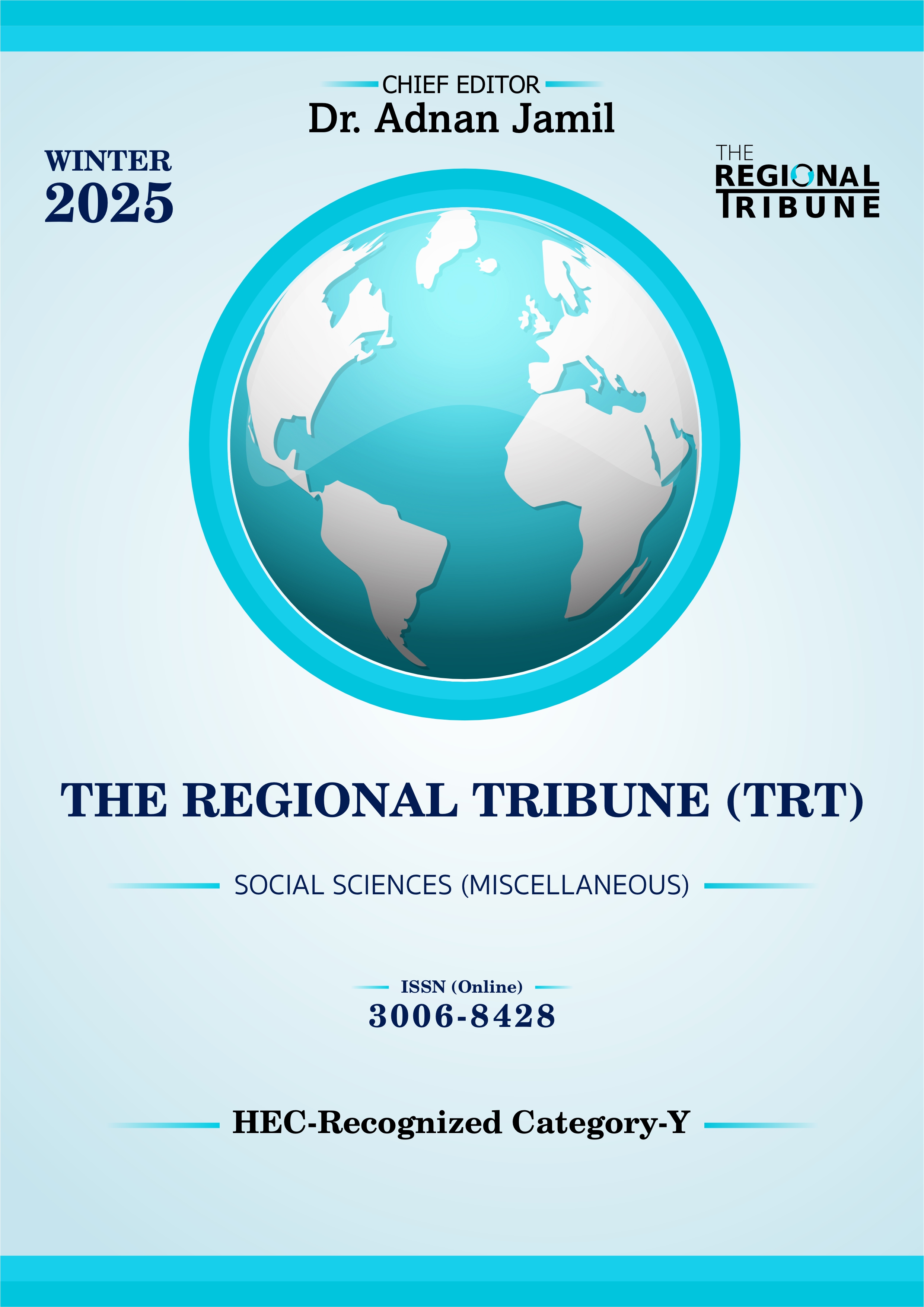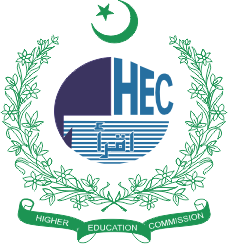Barriers and Opportunities: The Influence of Social and Cultural Dynamics on Girls' Secondary Education in Tribal Regions of Khyber Pakhtunkhwa, Pakistan
DOI:
https://doi.org/10.63062/trt/WR25.054Keywords:
Girls’ Education, Guardians’ Decision, Socio-cultural Factors, Equity of Opportunity in Education, Legal Framework in PakistanAbstract
Girls' education is one of the persistent dilemmas facing mostly tribal regions of developing countries, including Pakistan. This study explores the complex social and cultural factors that influence girls' secondary education in the tribal regions of Khyber Pakhtunkhwa, Pakistan, specifically focusing on the district Bajaur. The study aims to explore the barriers and opportunities surrounding post-primary girls' education. In this qualitative study, eighteen (18) male guardians of the girls were recruited for in-depth interviews using an interview guide through a purposive sampling technique. Thematic analysis technique was utilized to analyze the data while engaging "equity of opportunity in education" discourse as a theoretical framework to examine the socio-cultural dynamics of the region. The findings illustrate that most of the participants support both boys' and girls' secondary education, and many perceive the cultural environment as conducive to girls' secondary education. However, the study also reveals multifaceted challenges faced by young girls, including governmental neglect, illiterate parents, and the unavailability of educational facilities. These are the key barriers that discourage girls from pursuing post-primary schooling. The study offers key policy recommendations and highlights its theoretical and practical contributions to tackling the educational disparities faced by girls in tribal areas.
References
Ahmad, S. (2020). The FATA merger with Khyber–Pakhtunkhwa: Governance challenges and development opportunities. In Perspectives on Contemporary Pakistan (pp. 33–44). Routledge.
Ali, N. (2022, August 24). Education of girls. Pakistan Today. https://www.pakistantoday.com.pk/2022/08/24/education-of-girls
Amadeo, K. (2018). What Is Educational Equity, and Why Does It Matter? https://www.thebalancemoney.com/equity-in-education-4164737
Andiema, N. C. (2021). Influence of Culture on Girl Child Education in Central Pokot Sub County, Kenya. East African Journal of Education Studies, 3(1), 26–38. https://doi.org/10.37284/eajes.3.1.279
Arif, S. (2011). Broken Wings: Problems faced by Pakistani lady doctors in career development. International Journal of Academic Research in Business and Social Sciences, 1(1), 79-101.
Awan, A. G., & Malik, A. (2020). Impact of female education on poverty reduction: Evidence from Pakistan. Global Journal of Management, Social Sciences and Humanities, 6(2), 220-236.
Bureau Report. (2020, July 31). Education support program for girls launched in merged districts. International The News. https://www.thenews.com.pk/print/694699-education-support-programme-for-girls-launched-in-merged-districts
Buzdar, M. A., & Ali, A. (2011). Parents’ Attitude toward Daughters’ Education in Tribal Area of Dera Ghazi Khan (Pakistan). Turkish Online Journal of Qualitative Inquiry, 2(1), 16-23. https://doi.org/10.17569/tojqi.87839
Chingtham, T., & Guite, T. (2017). Parental attitude towards girl’s education. IOSR Journal of Research & Method in Education IOSR-JRME, 7(4), 1-6.
Clarke, V., & Braun, V. (2013). Teaching thematic analysis: Overcoming challenges and developing strategies for effective learning. The psychologist, 26(2), 120–123. https://uwe-repository.worktribe.com/preview/937606/Teaching%20.
Gauthier, R.-F. (2018). World Development Report 2018 «Learning to Realize Education’s Promise. Overview . Revue Internationale d’Éducation de Sèvres, 77, 27–29. https://doi.org/10.4000/ries.6107
Ghosh, G. S., & Deb, P. Parents’ Judgment towards Elementary Education of Tribal Children of Jalpaiguri District of West Bengal. International Journal of Current Trends in Science and Technology, 7(11). 20171–20180. https://doi.org/10.15520/ctst.v7i11.109
Herz, B. (2006). educating girls in South Asia: promising approaches. United Nations Children's Fund, Regional Office for South Asia.
Human Rights Watch, (2018). Shall I Feed My Daughter or Educate Her? Barriers to Girls‘Education in Pakistan. https://www.hrw.org/report/2018/11/12
IIPS. (2021). Gender Disparity in Education in Pakistan. Iqbal Institute of Policy Studies – IIPS website: https://iips.com.pk/gender-disparity-in-education-in-pakistan/
Inter-agency Network for Education in Emergencies (INEE). (2019). Gender equality in and through education. https://inee.org/sites/default/files/resources/INEE_GN_Gender_2019_0.pdf
Iqbal, K., Ranjha, A. N., & Khursheed, B. (2021). Role of parent’s education toward female higher education in society (A study of Multan). Journal of Educational Psychology and Pedagogical Sciences (JEPPS), 1(1), 1-9. https://jepps.su.edu.pk/article/
Jalal-ud-Din, M., & Khan, M. (2008). Socio-economic and cultural constraints of women in Pakistan with special reference to Mardan district, NWFP province. Sarhad Journal of Agriculture, 24(3), 485-493. https://api.semanticscholar.org/CorpusID:40204147
Kamal, A. (2022, February 27). Gender inequality in education. Pakistan Today. https://www.pakistantoday.com.pk/2022/02/27/gender-inequality-in-education/
Kaur, M., & Kaur, S. (2020). Parental attitude towards girls’ education and caste-class factors: insights from Punjab village. Journal of Critical Review, 7(10), 3038-3045. http://dx.doi.org/10.25215/1101.161
Khan, J. (2021). 73pc girls quit schools after primary education in ex-Fata: report - Daily Lead Pakistan. https://leadpakistan.com.pk/news/73pc-girls-quit-schools-after-primary-education-in-ex-fata-report-2/
Khan, M., Khan, G., & Muhammad, N. (2022). Barriers to Girl’s Education in Khyber Pakhtunkhwa, Pakistan: A Case Study of South Waziristan, Tehsil Makeen. The Discourse, 8(2), 1-15. https://discourse.org.pk/index.php/discourse/article/view/202
Khan, N. (2022, April 22). Erstwhile FATA deserves more. The Dayspring | Youth Centric Newspaper of Pakistan. https://www.thedayspring.com.pk/erstwhile-fata-deserves-more/
Khan, S. (2016). Impact of father education on female education in Pashtun society of district Charsadda, Pakistan. Imperial Journal of Interdisciplinary Research, 2(4), 1013-1019.
Khan, S. (2022, December 16). Ex-FATA remains centre of neglect since merger into KP. The Nation. https://www.nation.com.pk/16-Dec-2022/ex-fata-remains-centre-of-neglect-since-merger-into-kp.
Malik, A. S. (2021). Bringing Out-of-School girls Back to Education in Khyber Pakhtunkhwa. https://www.unicef.org/pakistan/stories/bringing-out-school-girls-back-education-khyber-pakhtunkhwa
McLeod, J. (2017). The administration of feminism in education: revisiting and remembering narratives of gender equity and identity. Journal of Educational Administration and History, 49(4), 283–300. https://doi.org/10.1080/00220620.2017.1343289
Mehmood, S., Chong, L., & Hussain, M. (2018). Females Higher Education in Pakistan: An Analysis of Socio-Economic and Cultural Challenges. Advances in Social Sciences Research Journal, 5(6). https://doi.org/10.14738/assrj.56.4658
Mustafa, S., Khan, M. S. A., & Jameel, K. (2016). Women Education in Pakistan: Is the Level Enough for Empowerment. International Journal of Scientific & Engineering Research, 7(8), 1747-1753.
Mwanza, B. (2017). The Effects of Cultural Practices on Educational Attainment of Rural Girls in Zambia. https://www.worldcces.org/article-3-by-mwanza/the-effects-of-cultural-practices-on-educational-attainment-of-rural-girls-in-zambia
Naveed, S. (2018). The importance of educating girls in the Newly Merged Districts of Khyber Pakhtunkhwa, Pakistan. Brookings. https://www.brookings.edu/articles/the-importance-of-educating-girls-in-the-newly-merged-districts-of-khyber-pakhtunkhwa-pakistan/
Naz, A., Ashraf, F., & Iqbal, S. (2020). The Relationship between Higher Education and Women Empowerment in Pakistan. UMT Education Review, 3(2), 65–84. https://doi.org/10.32350/uer.32.04
Onoyase, A. (2018). Attitude of Parents toward Female-Child Secondary Education in Sokoto State, Nigeria: Implications for Counselling. Journal of Educational and Social Research, 8(2), 21–27. https://doi.org/10.2478/jesr-2018-0012
Pakistan Labour Force Survey 2020-21. (2022). In Government of Pakistan Ministry of Planning, Development & Special Initiatives Pakistan Bureau of Statistics. https://www.pbs.gov.pk/sites/default/files/labour_force/publications/lfs2020_21/LFS_2020-21_Report.pdf
Parvez, A., Kamal, S., Ullah, M., Khan, M. S., & Khan, H. (2017). Effects of problems on female education at secondary school level in North Waziristan Agency. Research on Humanities and Social Sciences, 7(7), 1-6. https://core.ac.uk/download/pdf/234675926.pdf
Purewal, N., & Hashmi, N. (2014). Between returns and respectability: parental attitudes towards girls’ education in rural Punjab, Pakistan. British Journal of Sociology of Education, 36(7), 977–995. https://doi.org/10.1080/01425692.2014.883274
Ramachandran, V. (Ed.). (2004). Gender and social equity in primary education: Hierarchies of access. SAGE Publications India.
Roy, K. (2017). Why We Need Gender Equity Now. https://www.forbes.com/sites/ellevate/2017/09/14/why-we-need%20gender-equity%20now/?sh=6c2fdc0d77a2
Sahin, E. (2014). Gender Equity in Education. Open Journal of Social Sciences, 02(01), 59–63. https://doi.org/10.4236/jss.2014.21007
Sarker, M. N. I., Wu, M., & Hossin, M. A. (2019). Economic Effect of School Dropout in Bangladesh. International Journal of Information and Education Technology, 9(2), 136–142. https://doi.org/10.18178/ijiet.2019.9.2.1188
Shoukat, A., Maryam, I., Azam, R., & Hussain Ch, A. (2013). Impact of Parents’ Education on Children’s Academic Performance. Secondary Education Journal, 2 (1), 53-59. https://journal.tinkoff.ru/media/4_aqsa-maryam_v2_issue1.81xtdcuqbqef..pdf
Soika, B. (2020). Gender Equity in Education: Eight Ways to Reduce Bias [With Infographic]. https://rossier.usc.edu/gender-equity-in education-eight-ways-to-reduce-bias-with-info graphic/
Suleman, Q., Aslam, H. D., Habib, M. B., Yasmeen, K., Jalalian, M., Akhtar, Z., & Akhtar, B. (2015). Exploring Factors Affecting Girls' Education at Secondary Level: A Case of Karak District, Pakistan. Journal of Education and practice, 6(19), 95-109. https://eric.ed.gov/?id=EJ1079529
Sultan, R. S. (2022). Gender Inequality in Pakistan: An Assessment. Pakistan Social Science Review, 6(2), 221-23. http://doi.org/10.35484/pssr.2022 (6-II)20
Tembon, M., & Fort, L. (2008). Girls' education in the 21st century: gender equality, empowerment, and economic growth. Washington, DC: World Bank.
Tenny, S., Brannan, J. M., & Brannan, G. D. (2022). Qualitative Study. https://pubmed.ncbi.nlm.nih.gov/29262162/
Ullah, H. (2022). Post-Primary Girls Education in the Newly Merged Districts of Khyber Pakhtunkhwa. Journal of Elementary Education, 31(2), 13-30. http://111.68.103.26//journals/index.php/jee/article/view/4855
Ullah, K., Jan, A., Rani, M., Ahmad, M., & Khan, I. U. (2021). Factors affecting the female education in the newly merged district bajaur of khyber pakhtunkhwa, pakistan. Palarch's Journal of Archaeology of Egypt/Egyptology, 18(4), 3136-3156.
Ullah, R., Ullah, H., & Bilal, M. (2020). Biological versus Feminists Perspectives on Girls’ Underperformance in STEM Subjects in Pakistan. Liberal Arts and Social Sciences International Journal (LASSIJ), 4(1), 10–18. https://doi.org/10.47264/idea.lassij/4.1.2
UNICEF. (2019). Girls’ education. https://www.unicef.org/education/girls-education
UNICEF. (2019a). UNICEF Pakistan Annual Report 2018; UNICEF for every child. https://www.unicef.org/pakistan/reports/unicef-pakistan-annual-report-2018
UNICEF. (2020). UNICEF Annual Report 2019; UNICEF for Every Child. Reimagine New York. https://www.unicef.org/reports/annual-report-2019
VILLAIN. 2022. Equity and Equality in Education B.Ed. Notes | Equality of Educational Opportunities b.ed notes. https://www.bednotesatoz.in/2022/03/equity-and-equality-in-education-bed.html
Yakubova, P. M. (2020). The Effects of Traditional Gender Norms on the Fate of Girls' Education in Tajikistan [Doctoral dissertation, North Dakota State University].
Zeb, M., Ullah, A., Ullah, F., Haq, A., Ullah, I., Badshah, L., & Haq, M. A. (2023). Diversity and biological characteristics of macrofungi of district Bajaur, a remote area of Pakistan in the Hindu Kush range. Heliyon, 9(7), e17818–e17818. https://doi.org/10.1016/j.heliyon.2023.e17818
Downloads
Published
Issue
Section
License
Copyright (c) 2025 Kefayat Ullah

This work is licensed under a Creative Commons Attribution-NonCommercial 4.0 International License.



